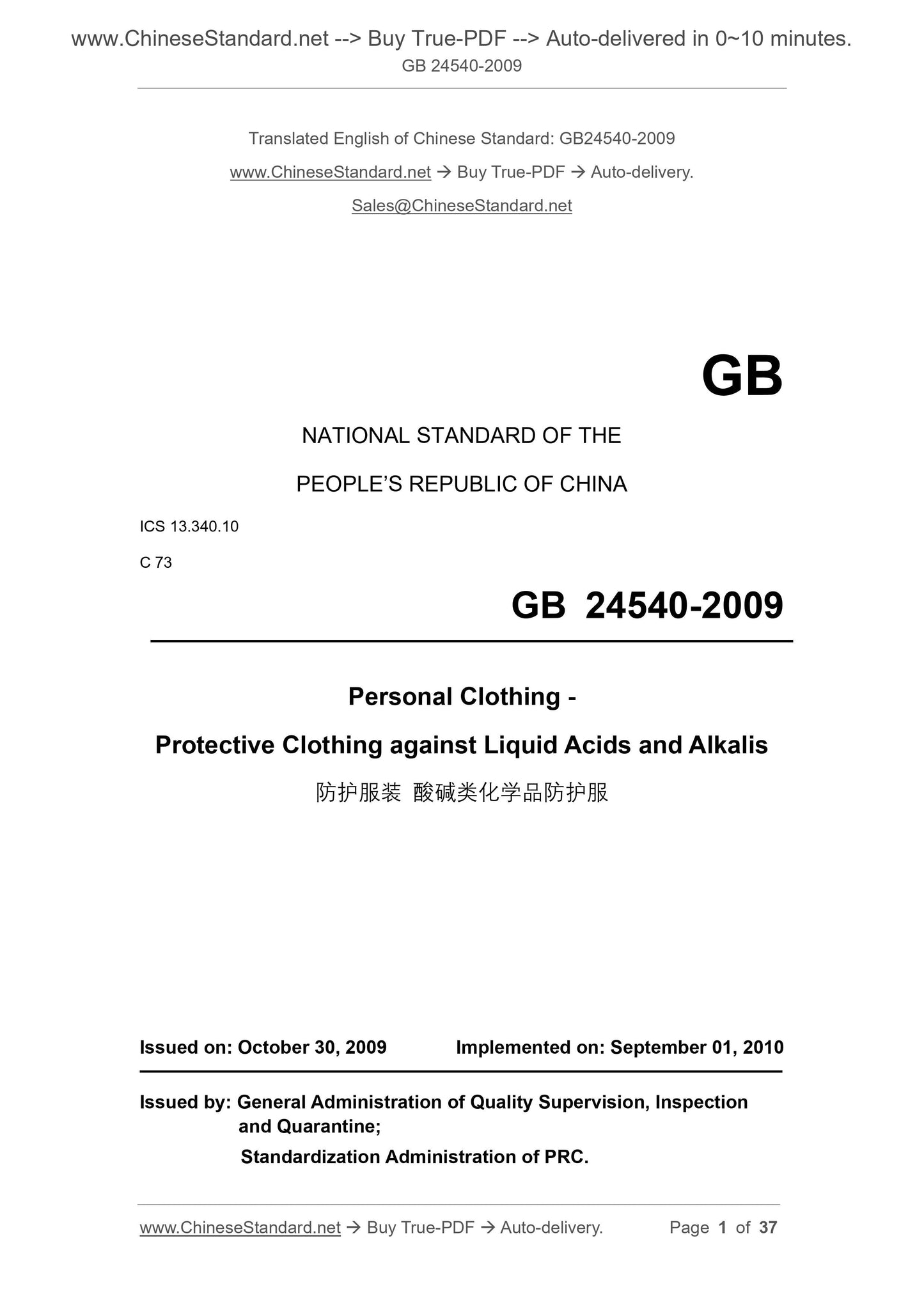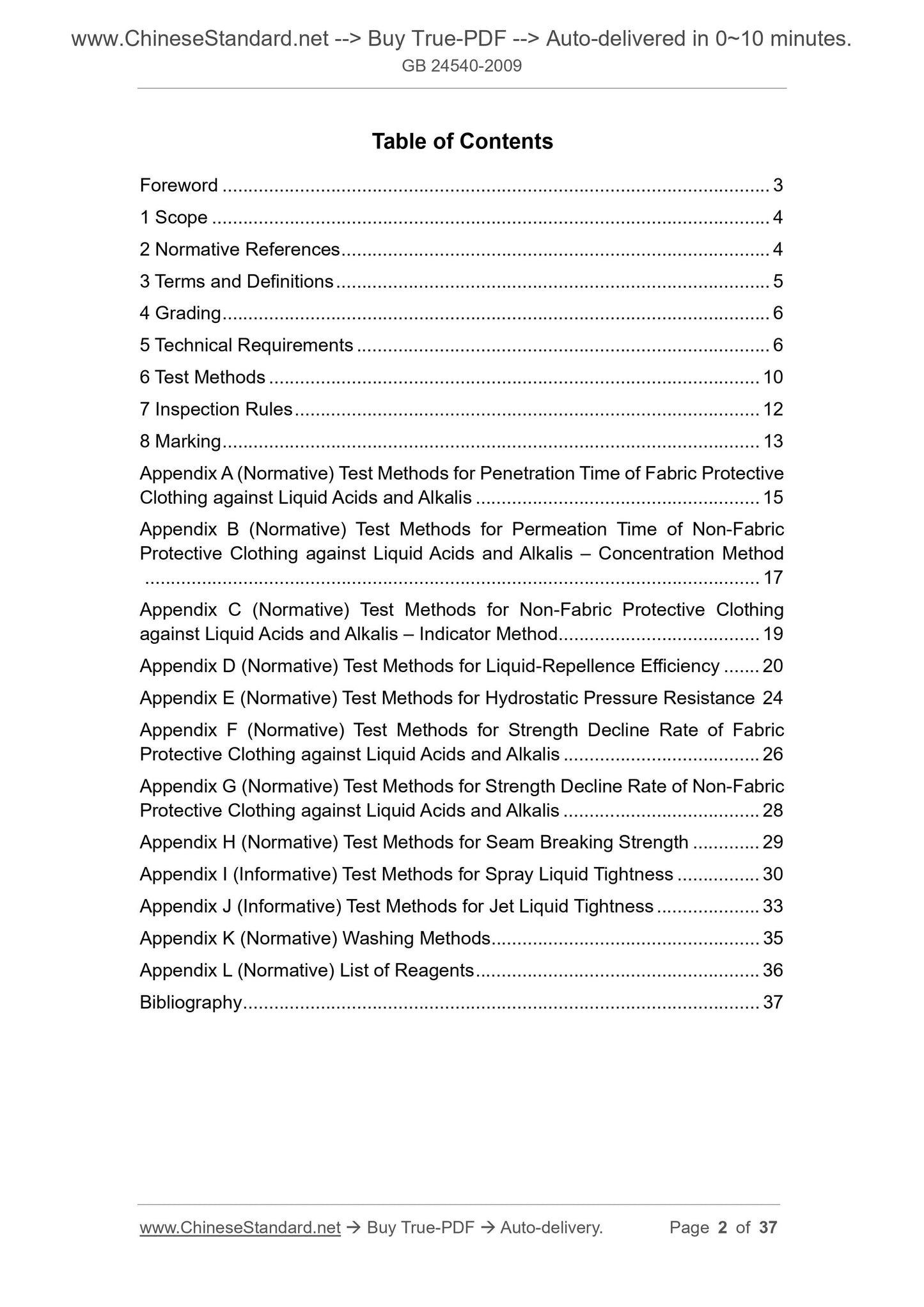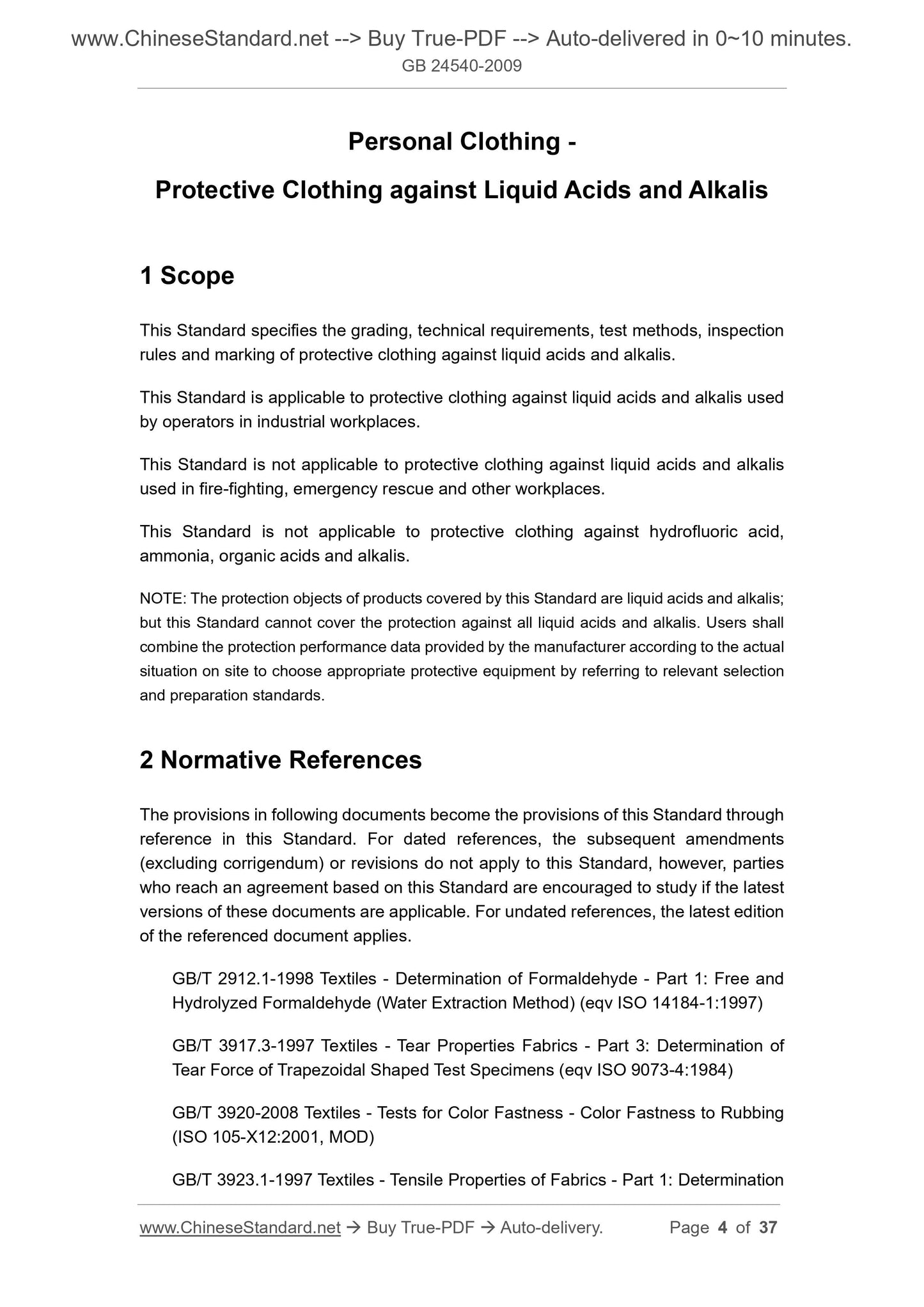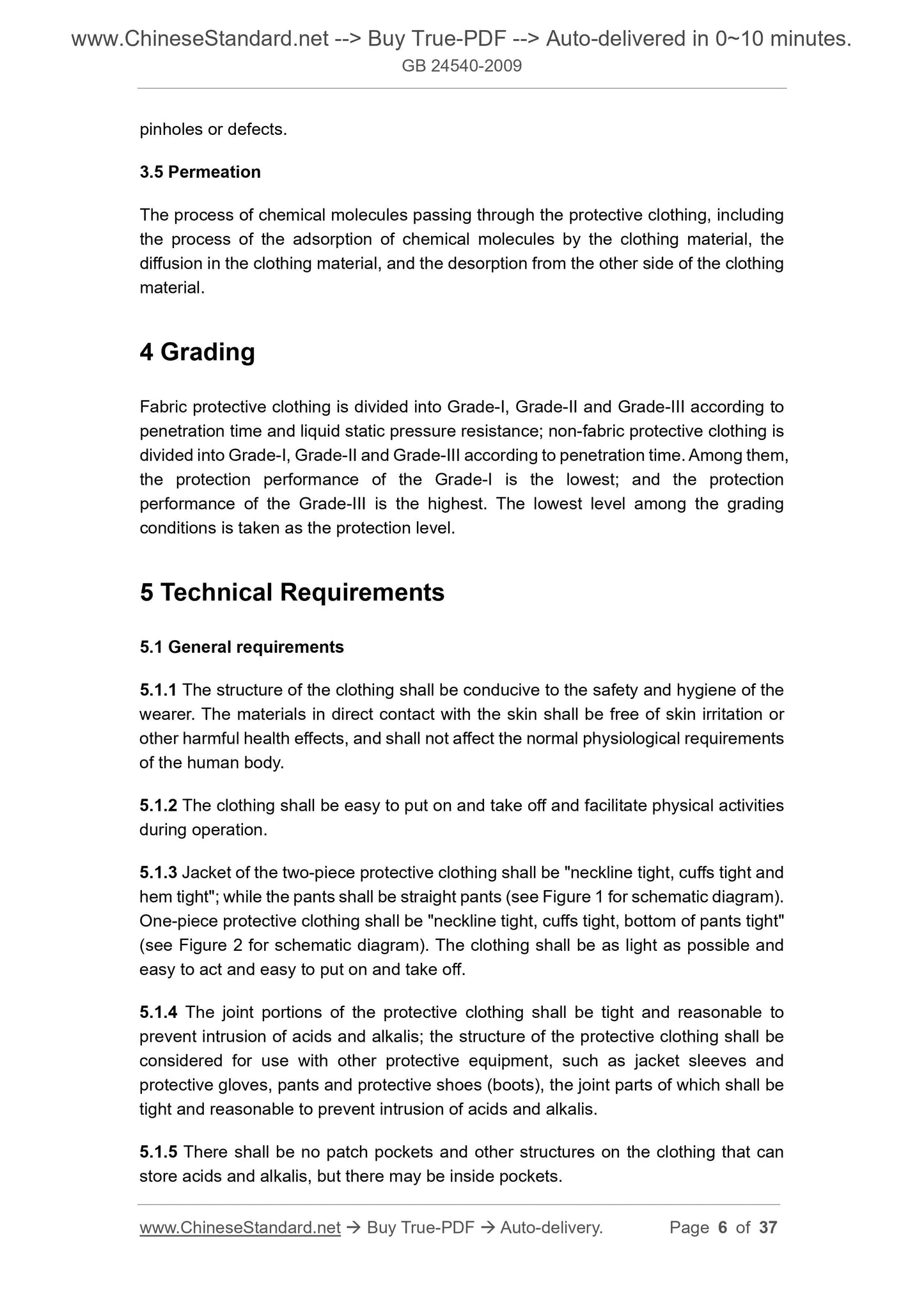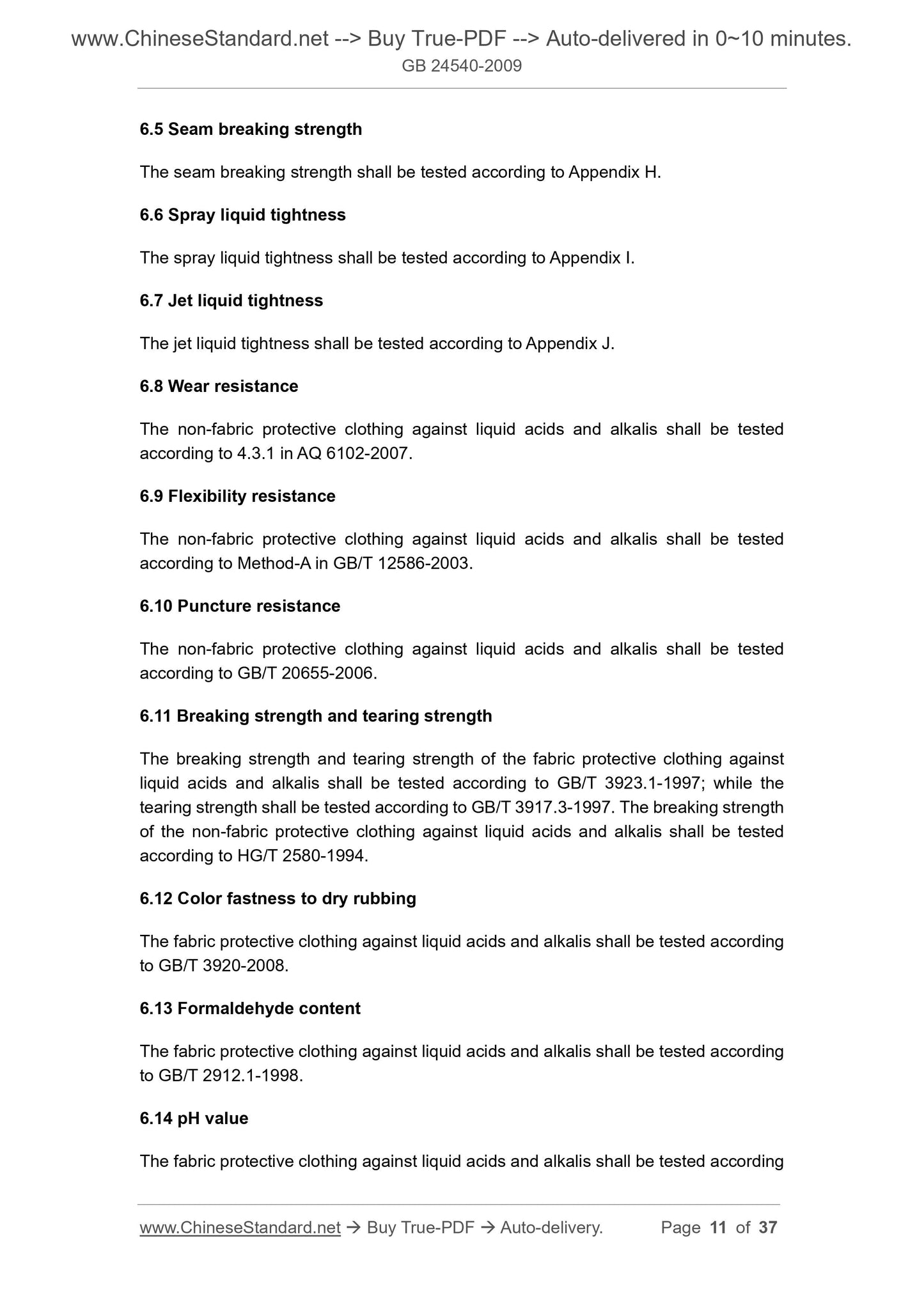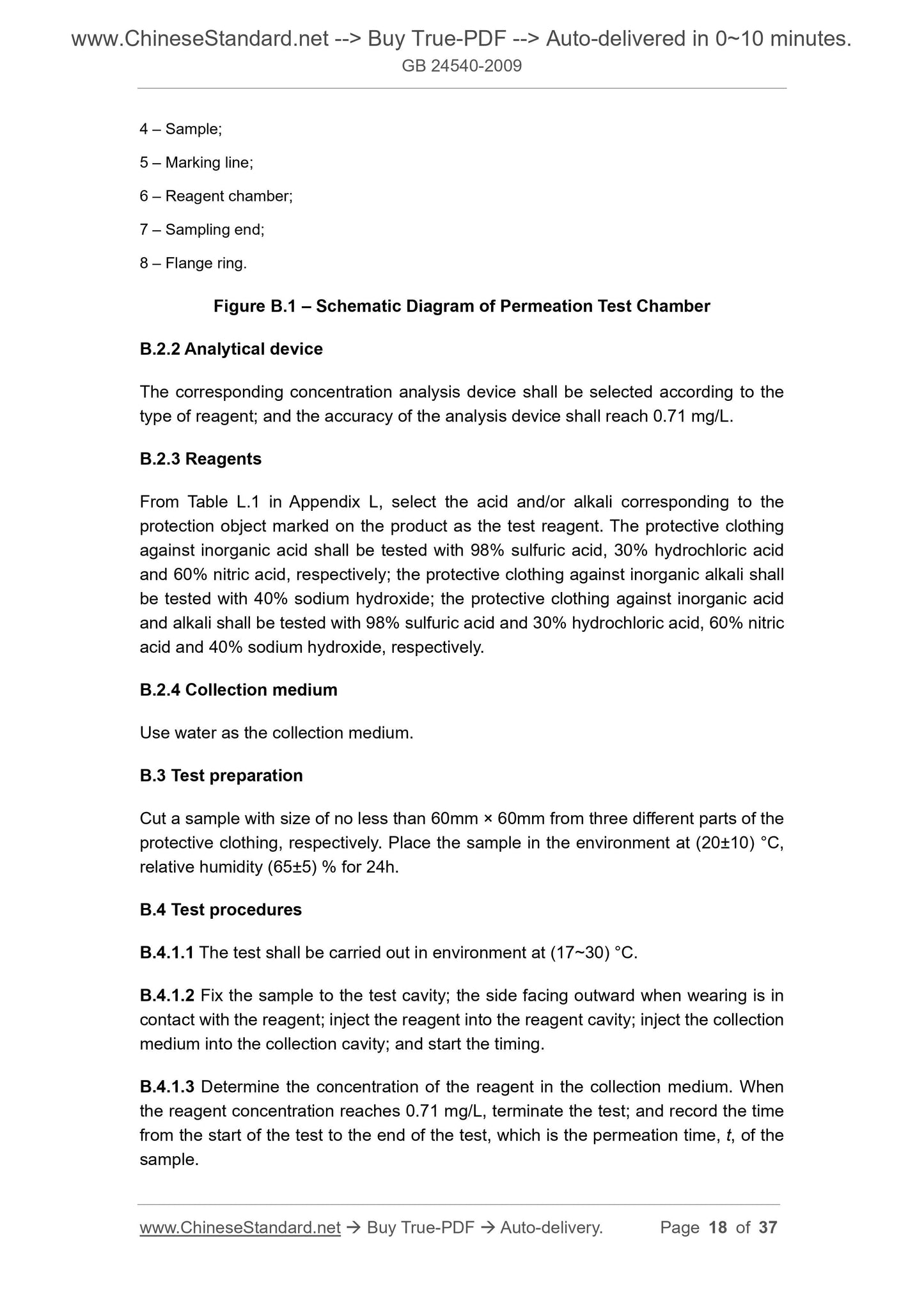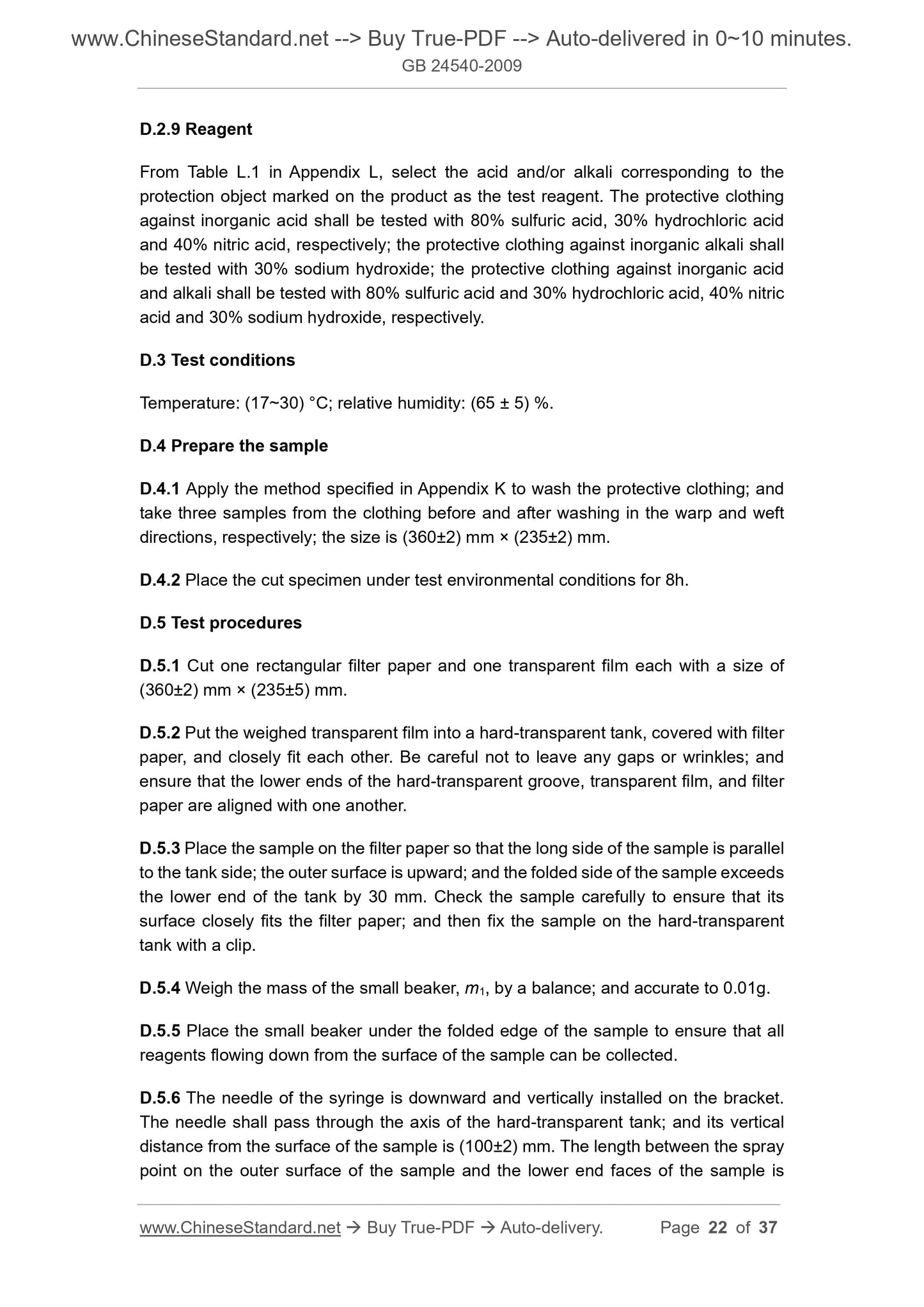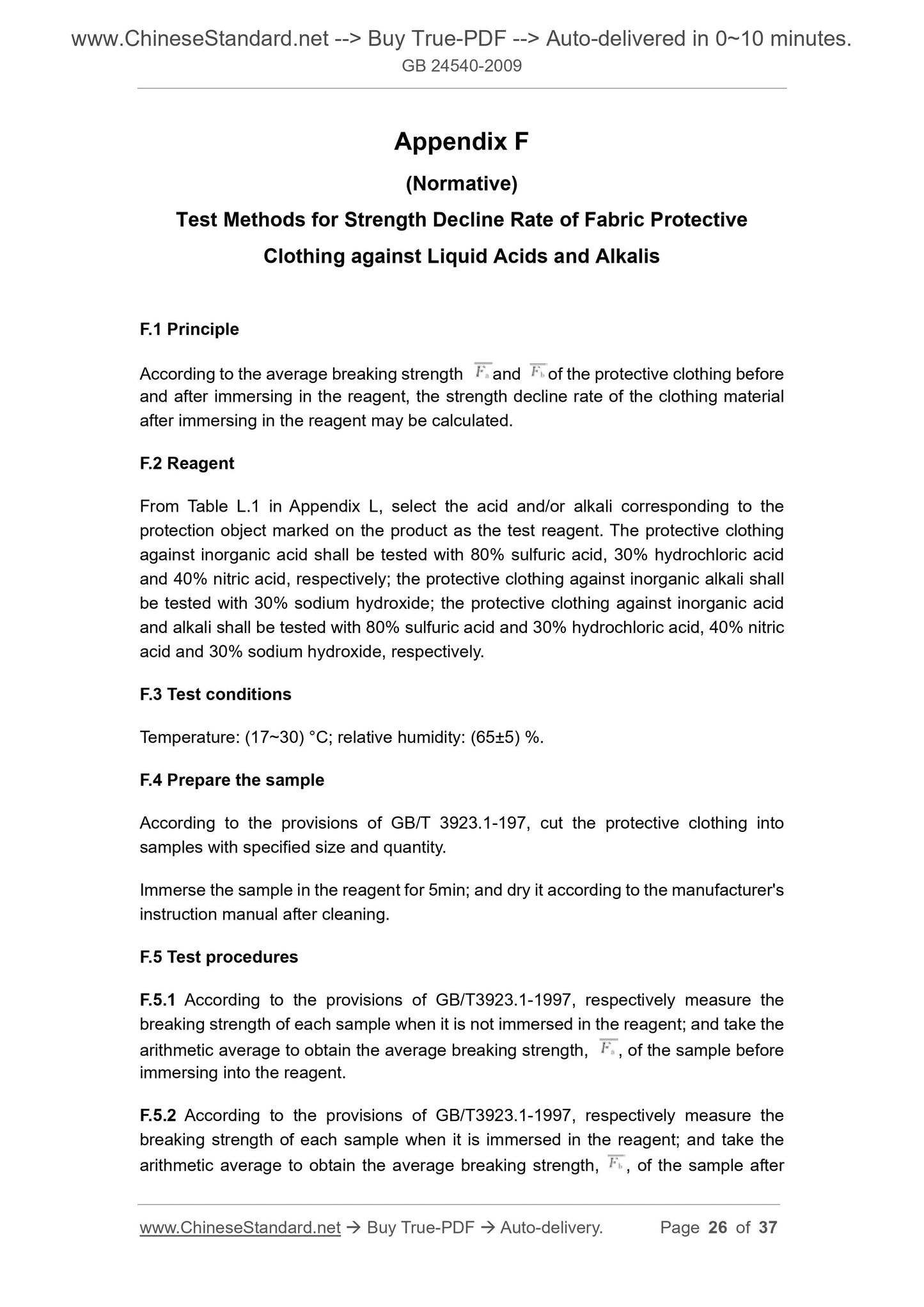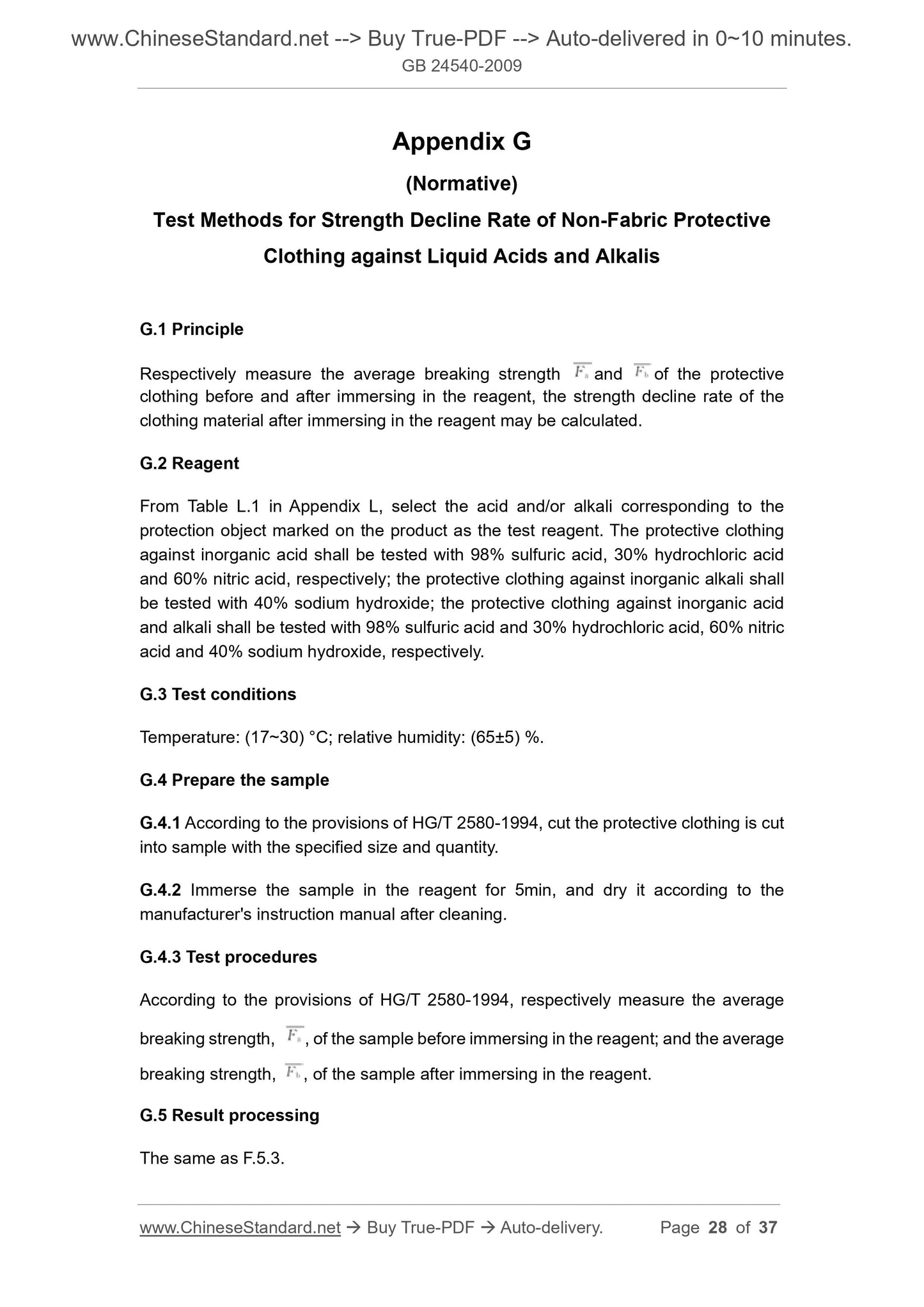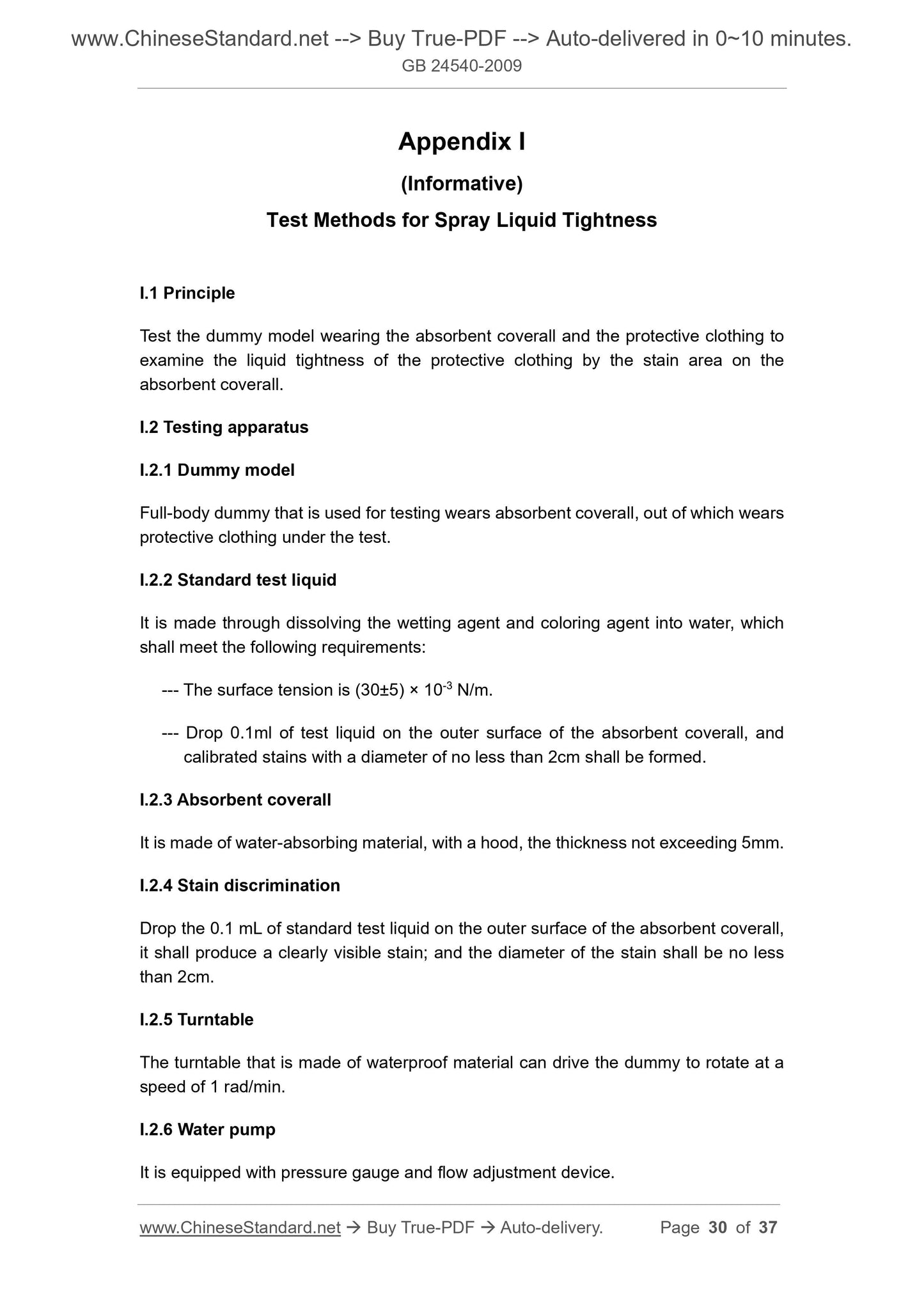1
/
of
10
www.ChineseStandard.us -- Field Test Asia Pte. Ltd.
GB 24540-2009 English PDF
GB 24540-2009 English PDF
Regular price
$320.00
Regular price
Sale price
$320.00
Unit price
/
per
Shipping calculated at checkout.
Couldn't load pickup availability
GB 24540-2009: Protective clothing -- Protective clothing against liquid acids and alkalis
Delivery: 9 seconds. Download (& Email) true-PDF + Invoice.
Get Quotation: Click GB 24540-2009 (Self-service in 1-minute)
Historical versions (Master-website): GB 24540-2009
Preview True-PDF (Reload/Scroll-down if blank)
GB 24540-2009
NATIONAL STANDARD OF THE
PEOPLE’S REPUBLIC OF CHINA
ICS 13.340.10
C 73
Personal Clothing -
Protective Clothing against Liquid Acids and Alkalis
ISSUED ON: OCTOBER 30, 2009
IMPLEMENTED ON: SEPTEMBER 01, 2010
Issued by: General Administration of Quality Supervision, Inspection
and Quarantine;
Standardization Administration of PRC.
Table of Contents
Foreword ... 3
1 Scope ... 4
2 Normative References ... 4
3 Terms and Definitions ... 5
4 Grading ... 6
5 Technical Requirements ... 6
6 Test Methods ... 10
7 Inspection Rules ... 12
8 Marking ... 13
Appendix A (Normative) Test Methods for Penetration Time of Fabric Protective
Clothing against Liquid Acids and Alkalis ... 15
Appendix B (Normative) Test Methods for Permeation Time of Non-Fabric
Protective Clothing against Liquid Acids and Alkalis – Concentration Method
... 17
Appendix C (Normative) Test Methods for Non-Fabric Protective Clothing
against Liquid Acids and Alkalis – Indicator Method ... 19
Appendix D (Normative) Test Methods for Liquid-Repellence Efficiency ... 20
Appendix E (Normative) Test Methods for Hydrostatic Pressure Resistance 24
Appendix F (Normative) Test Methods for Strength Decline Rate of Fabric
Protective Clothing against Liquid Acids and Alkalis ... 26
Appendix G (Normative) Test Methods for Strength Decline Rate of Non-Fabric
Protective Clothing against Liquid Acids and Alkalis ... 28
Appendix H (Normative) Test Methods for Seam Breaking Strength ... 29
Appendix I (Informative) Test Methods for Spray Liquid Tightness ... 30
Appendix J (Informative) Test Methods for Jet Liquid Tightness ... 33
Appendix K (Normative) Washing Methods ... 35
Appendix L (Normative) List of Reagents ... 36
Bibliography ... 37
Personal Clothing -
Protective Clothing against Liquid Acids and Alkalis
1 Scope
This Standard specifies the grading, technical requirements, test methods, inspection
rules and marking of protective clothing against liquid acids and alkalis.
This Standard is applicable to protective clothing against liquid acids and alkalis used
by operators in industrial workplaces.
This Standard is not applicable to protective clothing against liquid acids and alkalis
used in fire-fighting, emergency rescue and other workplaces.
This Standard is not applicable to protective clothing against hydrofluoric acid,
ammonia, organic acids and alkalis.
NOTE: The protection objects of products covered by this Standard are liquid acids and alkalis;
but this Standard cannot cover the protection against all liquid acids and alkalis. Users shall
combine the protection performance data provided by the manufacturer according to the actual
situation on site to choose appropriate protective equipment by referring to relevant selection
and preparation standards.
2 Normative References
The provisions in following documents become the provisions of this Standard through
reference in this Standard. For dated references, the subsequent amendments
(excluding corrigendum) or revisions do not apply to this Standard, however, parties
who reach an agreement based on this Standard are encouraged to study if the latest
versions of these documents are applicable. For undated references, the latest edition
of the referenced document applies.
GB/T 2912.1-1998 Textiles - Determination of Formaldehyde - Part 1: Free and
Hydrolyzed Formaldehyde (Water Extraction Method) (eqv ISO 14184-1:1997)
GB/T 3917.3-1997 Textiles - Tear Properties Fabrics - Part 3: Determination of
Tear Force of Trapezoidal Shaped Test Specimens (eqv ISO 9073-4:1984)
GB/T 3920-2008 Textiles - Tests for Color Fastness - Color Fastness to Rubbing
(ISO 105-X12:2001, MOD)
GB/T 3923.1-1997 Textiles - Tensile Properties of Fabrics - Part 1: Determination
pinholes or defects.
3.5 Permeation
The process of chemical molecules passing through the protective clothing, including
the process of the adsorption of chemical molecules by the clothing material, the
diffusion in the clothing material, and the desorption from the other side of the clothing
material.
4 Grading
Fabric protective clothing is divided into Grade-I, Grade-II and Grade-III according to
penetration time and liquid static pressure resistance; non-fabric protective clothing is
divided into Grade-I, Grade-II and Grade-III according to penetration time. Among them,
the protection performance of the Grade-I is the lowest; and the protection
performance of the Grade-III is the highest. The lowest level among the grading
conditions is taken as the protection level.
5 Technical Requirements
5.1 General requirements
5.1.1 The structure of the clothing shall be conducive to the safety and hygiene of the
wearer. The materials in direct contact with the skin shall be free of skin irritation or
other harmful health effects, and shall not affect the normal physiological requirements
of the human body.
5.1.2 The clothing shall be easy to put on and take off and facilitate physical activities
during operation.
5.1.3 Jacket of the two-piece protective clothing shall be "neckline tight, cuffs tight and
hem tight"; while the pants shall be straight pants (see Figure 1 for schematic diagram).
One-piece protective clothing shall be "neckline tight, cuffs tight, bottom of pants tight"
(see Figure 2 for schematic diagram). The clothing shall be as light as possible and
easy to act and easy to put on and take off.
5.1.4 The joint portions of the protective clothing shall be tight and reasonable to
prevent intrusion of acids and alkalis; the structure of the protective clothing shall be
considered for use with other protective equipment, such as jacket sleeves and
protective gloves, pants and protective shoes (boots), the joint parts of which shall be
tight and reasonable to prevent intrusion of acids and alkalis.
5.1.5 There shall be no patch pockets and other structures on the clothing that can
store acids and alkalis, but there may be inside pockets.
6.5 Seam breaking strength
The seam breaking strength shall be tested according to Appendix H.
6.6 Spray liquid tightness
The spray liquid tightness shall be tested according to Appendix I.
6.7 Jet liquid tightness
The jet liquid tightness shall be tested according to Appendix J.
6.8 Wear resistance
The non-fabric protective clothing against liquid acids and alkalis shall be tested
according to 4.3.1 in AQ 6102-2007.
6.9 Flexibility resistance
The non-fabric protective clothing against liquid acids and alkalis shall be tested
according to Method-A in GB/T 12586-2003.
6.10 Puncture resistance
The non-fabric protective clothing against liquid acids and alkalis shall be tested
according to GB/T 20655-2006.
6.11 Breaking strength and tearing strength
The breaking strength and tearing strength of the fabric protective clothing against
liquid acids and alkalis shall be tested according to GB/T 3923.1-1997; while the
tearing strength shall be tested according to GB/T 3917.3-1997. The breaking strength
of the non-fabric protective clothing against liquid acids and alkalis shall be tested
according to HG/T 2580-1994.
6.12 Color fastness to dry rubbing
The fabric protective clothing against liquid acids and alkalis shall be tested according
to GB/T 3920-2008.
6.13 Formaldehyde content
The fabric protective clothing against liquid acids and alkalis shall be tested according
to GB/T 2912.1-1998.
6.14 pH value
The fabric protective clothing against liquid acids and alkalis shall be tested according
4 – Sample;
5 – Marking line;
6 – Reagent chamber;
7 – Sampling end;
8 – Flange ring.
Figure B.1 – Schematic Diagram of Permeation Test Chamber
B.2.2 Analytical device
The corresponding concentration analysis device shall be selected according to the
type of reagent; and the accuracy of the analysis device shall reach 0.71 mg/L.
B.2.3 Reagents
From Table L.1 in Appendix L, select the acid and/or alkali corresponding to the
protection object marked on the product as the test reagent. The protective clothing
against inorganic acid shall be tested with 98% sulfuric acid, 30% hydrochloric acid
and 60% nitric acid, respectively; the protective clothing against inorganic alkali shall
be tested with 40% sodium hydroxide; the protective clothing against inorganic acid
and alkali shall be tested with 98% sulfuric acid and 30% hydrochloric acid, 60% nitric
acid and 40% sodium hydroxide, respectively.
B.2.4 Collection medium
Use water as the collection medium.
B.3 Test preparation
Cut a sample with size of no less than 60mm × 60mm from three different parts of the
protective clothing, respectively. Place the sample in the environment at (20±10) °C,
relative humidity (65±5) % for 24h.
B.4 Test procedures
B.4.1.1 The test shall be carried out in environment at (17~30) °C.
B.4.1.2 Fix the sample to the test cavity; the side facing outward when wearing is in
contact with the reagent; inject the reagent into the reagent cavity; inject the collection
medium into the collection cavity; and start the timing.
B.4.1.3 Determine the concentration of the reagent in the collection medium. When
the reagent concentration reaches 0.71 mg/L, terminate the test; and record the time
from the start of the test to the end of the test, which is the permeation time, t, of the
sample.
D.2.9 Reagent
From Table L.1 in Appendix L, select the acid and/or alkali corresponding to the
protection object marked on the product as the test reagent. The protective clothing
against inorganic acid shall be tested with 80% sulfuric acid, 30% hydrochloric acid
and 40% nitric acid, respectively; the protective clothing against inorganic alkali shall
be tested with 30% sodium hydroxide; the protective clothing against inorganic acid
and alkali shall be tested with 80% sulfuric acid and 30% hydrochloric acid, 40% nitric
acid and 30% sodium hydroxide, respectively.
D.3 Test conditions
Temperature: (17~30) °C; relative humidity: (65 ± 5) %.
D.4 Prepare the sample
D.4.1 Apply the method specified in Appendix K to wash the protective clothing; and
take three samples from the clothing before and after washing in the warp and weft
directions, respectively; the size is (360±2) mm × (235±2) mm.
D.4.2 Place the cut specimen under test environmental conditions for 8h.
D.5 Test procedures
D.5.1 Cut one rectangular filter paper and one transparent film each with a size of
(360±2) mm × (235±5) mm.
D.5.2 Put the weighed transparent film into a hard-transparent tank, covered with filter
paper, and closely fit each other. Be careful not to leave any gaps or wrinkles; and
ensure that the lower ends of the hard-transparent groove, transparent film, and filter
paper are aligned with one another.
D.5.3 Place the sample on the filter paper so that the long side of the sample is parallel
to the tank side; the outer surface is upward; and the folded side of the sample exceeds
the lower end of the tank by 30 mm. Check the sample carefully to ensure that its
surface closely fits the filter paper; and then fix the sample on the hard-transparent
tank with a clip.
D.5.4 Weigh the mass of the small beaker, m1, by a balance; and accurate to 0.01g.
D.5.5 Place the small beaker under the folded edge of the sample to ensure that all
reagents flowing down from the surface of the sample can be collected.
D.5.6 The needle of the syringe is downward and vertically installed on the bracket.
The needle shall pass through the axis of the hard-transparent tank; and its vertical
distance from the surface of the sample is (100±2) mm. The length between the spray
point on the outer surface of the sample and the lower end faces of the sample is
Appendix F
(Normative)
Test Methods for Strength Decline Rate of Fabric Protective
Clothing against Liquid Acids and Alkalis
F.1 Principle
According to the average breaking strength and of the protective clothing before
and after immersing in the reagent, the strength decline rate of the clothing material
after immersing in the reagent may be calculated.
F.2 Reagent
From Table L.1 in Appendix L, select the acid and/or alkali corresponding to the
protection object marked on the product as the test reagent. The protective clothing
against inorganic acid shall be tested with 80% sulfuric acid, 30% hydrochloric acid
and 40% nitric acid, respectively; the protective clothing against inorganic alkali shall
be tested with 30% sodium hydroxide; the protective clothing against inorganic acid
and alkali shall be tested with 80% sulfuric acid and 30% hydrochloric acid, 40% nitric
acid and 30% sodium hydroxide, respectively.
F.3 Test conditions
Temperature: (17~30) °C; relative humidity: (65±5) %.
F.4 Prepare the sample
According to the provisions of GB/T 3923.1-197, cut the protective clothing into
samples with specified size and quantity.
Immerse the sample in the reagent for 5min; and dry it according to the manufacturer's
instruction manual after cleaning.
F.5 Test procedures
F.5.1 According to the provisions of GB/T3923.1-1997, respectively measure the
breaking strength of each sample when it is not immersed in the reagent; and take the
arithmetic average to obtain the average breaking strength, , of the sample before
immersing into the reagent.
F.5.2 According to the provisions of GB/T3923.1-1997, respectively measure the
breaking strength of each sample when it is immersed in the reagent; and take the
arithmetic average to obtain the average breaking strength, , of the sample after
Appendix G
(Normative)
Test Methods for Strength Decline Rate of Non-Fabric Protective
Clothing against Liquid Acids and Alkalis
G.1 Principle
Respectively measure the average breaking strength and of the protective
clothing before and after immersing in the reagent, the strength decline rate of the
clothing material after immersing in the reagent may be calculated.
G.2 Reagent
From Table L.1 in Appendix L, select the acid and/or alkali corresponding to th...
Delivery: 9 seconds. Download (& Email) true-PDF + Invoice.
Get Quotation: Click GB 24540-2009 (Self-service in 1-minute)
Historical versions (Master-website): GB 24540-2009
Preview True-PDF (Reload/Scroll-down if blank)
GB 24540-2009
NATIONAL STANDARD OF THE
PEOPLE’S REPUBLIC OF CHINA
ICS 13.340.10
C 73
Personal Clothing -
Protective Clothing against Liquid Acids and Alkalis
ISSUED ON: OCTOBER 30, 2009
IMPLEMENTED ON: SEPTEMBER 01, 2010
Issued by: General Administration of Quality Supervision, Inspection
and Quarantine;
Standardization Administration of PRC.
Table of Contents
Foreword ... 3
1 Scope ... 4
2 Normative References ... 4
3 Terms and Definitions ... 5
4 Grading ... 6
5 Technical Requirements ... 6
6 Test Methods ... 10
7 Inspection Rules ... 12
8 Marking ... 13
Appendix A (Normative) Test Methods for Penetration Time of Fabric Protective
Clothing against Liquid Acids and Alkalis ... 15
Appendix B (Normative) Test Methods for Permeation Time of Non-Fabric
Protective Clothing against Liquid Acids and Alkalis – Concentration Method
... 17
Appendix C (Normative) Test Methods for Non-Fabric Protective Clothing
against Liquid Acids and Alkalis – Indicator Method ... 19
Appendix D (Normative) Test Methods for Liquid-Repellence Efficiency ... 20
Appendix E (Normative) Test Methods for Hydrostatic Pressure Resistance 24
Appendix F (Normative) Test Methods for Strength Decline Rate of Fabric
Protective Clothing against Liquid Acids and Alkalis ... 26
Appendix G (Normative) Test Methods for Strength Decline Rate of Non-Fabric
Protective Clothing against Liquid Acids and Alkalis ... 28
Appendix H (Normative) Test Methods for Seam Breaking Strength ... 29
Appendix I (Informative) Test Methods for Spray Liquid Tightness ... 30
Appendix J (Informative) Test Methods for Jet Liquid Tightness ... 33
Appendix K (Normative) Washing Methods ... 35
Appendix L (Normative) List of Reagents ... 36
Bibliography ... 37
Personal Clothing -
Protective Clothing against Liquid Acids and Alkalis
1 Scope
This Standard specifies the grading, technical requirements, test methods, inspection
rules and marking of protective clothing against liquid acids and alkalis.
This Standard is applicable to protective clothing against liquid acids and alkalis used
by operators in industrial workplaces.
This Standard is not applicable to protective clothing against liquid acids and alkalis
used in fire-fighting, emergency rescue and other workplaces.
This Standard is not applicable to protective clothing against hydrofluoric acid,
ammonia, organic acids and alkalis.
NOTE: The protection objects of products covered by this Standard are liquid acids and alkalis;
but this Standard cannot cover the protection against all liquid acids and alkalis. Users shall
combine the protection performance data provided by the manufacturer according to the actual
situation on site to choose appropriate protective equipment by referring to relevant selection
and preparation standards.
2 Normative References
The provisions in following documents become the provisions of this Standard through
reference in this Standard. For dated references, the subsequent amendments
(excluding corrigendum) or revisions do not apply to this Standard, however, parties
who reach an agreement based on this Standard are encouraged to study if the latest
versions of these documents are applicable. For undated references, the latest edition
of the referenced document applies.
GB/T 2912.1-1998 Textiles - Determination of Formaldehyde - Part 1: Free and
Hydrolyzed Formaldehyde (Water Extraction Method) (eqv ISO 14184-1:1997)
GB/T 3917.3-1997 Textiles - Tear Properties Fabrics - Part 3: Determination of
Tear Force of Trapezoidal Shaped Test Specimens (eqv ISO 9073-4:1984)
GB/T 3920-2008 Textiles - Tests for Color Fastness - Color Fastness to Rubbing
(ISO 105-X12:2001, MOD)
GB/T 3923.1-1997 Textiles - Tensile Properties of Fabrics - Part 1: Determination
pinholes or defects.
3.5 Permeation
The process of chemical molecules passing through the protective clothing, including
the process of the adsorption of chemical molecules by the clothing material, the
diffusion in the clothing material, and the desorption from the other side of the clothing
material.
4 Grading
Fabric protective clothing is divided into Grade-I, Grade-II and Grade-III according to
penetration time and liquid static pressure resistance; non-fabric protective clothing is
divided into Grade-I, Grade-II and Grade-III according to penetration time. Among them,
the protection performance of the Grade-I is the lowest; and the protection
performance of the Grade-III is the highest. The lowest level among the grading
conditions is taken as the protection level.
5 Technical Requirements
5.1 General requirements
5.1.1 The structure of the clothing shall be conducive to the safety and hygiene of the
wearer. The materials in direct contact with the skin shall be free of skin irritation or
other harmful health effects, and shall not affect the normal physiological requirements
of the human body.
5.1.2 The clothing shall be easy to put on and take off and facilitate physical activities
during operation.
5.1.3 Jacket of the two-piece protective clothing shall be "neckline tight, cuffs tight and
hem tight"; while the pants shall be straight pants (see Figure 1 for schematic diagram).
One-piece protective clothing shall be "neckline tight, cuffs tight, bottom of pants tight"
(see Figure 2 for schematic diagram). The clothing shall be as light as possible and
easy to act and easy to put on and take off.
5.1.4 The joint portions of the protective clothing shall be tight and reasonable to
prevent intrusion of acids and alkalis; the structure of the protective clothing shall be
considered for use with other protective equipment, such as jacket sleeves and
protective gloves, pants and protective shoes (boots), the joint parts of which shall be
tight and reasonable to prevent intrusion of acids and alkalis.
5.1.5 There shall be no patch pockets and other structures on the clothing that can
store acids and alkalis, but there may be inside pockets.
6.5 Seam breaking strength
The seam breaking strength shall be tested according to Appendix H.
6.6 Spray liquid tightness
The spray liquid tightness shall be tested according to Appendix I.
6.7 Jet liquid tightness
The jet liquid tightness shall be tested according to Appendix J.
6.8 Wear resistance
The non-fabric protective clothing against liquid acids and alkalis shall be tested
according to 4.3.1 in AQ 6102-2007.
6.9 Flexibility resistance
The non-fabric protective clothing against liquid acids and alkalis shall be tested
according to Method-A in GB/T 12586-2003.
6.10 Puncture resistance
The non-fabric protective clothing against liquid acids and alkalis shall be tested
according to GB/T 20655-2006.
6.11 Breaking strength and tearing strength
The breaking strength and tearing strength of the fabric protective clothing against
liquid acids and alkalis shall be tested according to GB/T 3923.1-1997; while the
tearing strength shall be tested according to GB/T 3917.3-1997. The breaking strength
of the non-fabric protective clothing against liquid acids and alkalis shall be tested
according to HG/T 2580-1994.
6.12 Color fastness to dry rubbing
The fabric protective clothing against liquid acids and alkalis shall be tested according
to GB/T 3920-2008.
6.13 Formaldehyde content
The fabric protective clothing against liquid acids and alkalis shall be tested according
to GB/T 2912.1-1998.
6.14 pH value
The fabric protective clothing against liquid acids and alkalis shall be tested according
4 – Sample;
5 – Marking line;
6 – Reagent chamber;
7 – Sampling end;
8 – Flange ring.
Figure B.1 – Schematic Diagram of Permeation Test Chamber
B.2.2 Analytical device
The corresponding concentration analysis device shall be selected according to the
type of reagent; and the accuracy of the analysis device shall reach 0.71 mg/L.
B.2.3 Reagents
From Table L.1 in Appendix L, select the acid and/or alkali corresponding to the
protection object marked on the product as the test reagent. The protective clothing
against inorganic acid shall be tested with 98% sulfuric acid, 30% hydrochloric acid
and 60% nitric acid, respectively; the protective clothing against inorganic alkali shall
be tested with 40% sodium hydroxide; the protective clothing against inorganic acid
and alkali shall be tested with 98% sulfuric acid and 30% hydrochloric acid, 60% nitric
acid and 40% sodium hydroxide, respectively.
B.2.4 Collection medium
Use water as the collection medium.
B.3 Test preparation
Cut a sample with size of no less than 60mm × 60mm from three different parts of the
protective clothing, respectively. Place the sample in the environment at (20±10) °C,
relative humidity (65±5) % for 24h.
B.4 Test procedures
B.4.1.1 The test shall be carried out in environment at (17~30) °C.
B.4.1.2 Fix the sample to the test cavity; the side facing outward when wearing is in
contact with the reagent; inject the reagent into the reagent cavity; inject the collection
medium into the collection cavity; and start the timing.
B.4.1.3 Determine the concentration of the reagent in the collection medium. When
the reagent concentration reaches 0.71 mg/L, terminate the test; and record the time
from the start of the test to the end of the test, which is the permeation time, t, of the
sample.
D.2.9 Reagent
From Table L.1 in Appendix L, select the acid and/or alkali corresponding to the
protection object marked on the product as the test reagent. The protective clothing
against inorganic acid shall be tested with 80% sulfuric acid, 30% hydrochloric acid
and 40% nitric acid, respectively; the protective clothing against inorganic alkali shall
be tested with 30% sodium hydroxide; the protective clothing against inorganic acid
and alkali shall be tested with 80% sulfuric acid and 30% hydrochloric acid, 40% nitric
acid and 30% sodium hydroxide, respectively.
D.3 Test conditions
Temperature: (17~30) °C; relative humidity: (65 ± 5) %.
D.4 Prepare the sample
D.4.1 Apply the method specified in Appendix K to wash the protective clothing; and
take three samples from the clothing before and after washing in the warp and weft
directions, respectively; the size is (360±2) mm × (235±2) mm.
D.4.2 Place the cut specimen under test environmental conditions for 8h.
D.5 Test procedures
D.5.1 Cut one rectangular filter paper and one transparent film each with a size of
(360±2) mm × (235±5) mm.
D.5.2 Put the weighed transparent film into a hard-transparent tank, covered with filter
paper, and closely fit each other. Be careful not to leave any gaps or wrinkles; and
ensure that the lower ends of the hard-transparent groove, transparent film, and filter
paper are aligned with one another.
D.5.3 Place the sample on the filter paper so that the long side of the sample is parallel
to the tank side; the outer surface is upward; and the folded side of the sample exceeds
the lower end of the tank by 30 mm. Check the sample carefully to ensure that its
surface closely fits the filter paper; and then fix the sample on the hard-transparent
tank with a clip.
D.5.4 Weigh the mass of the small beaker, m1, by a balance; and accurate to 0.01g.
D.5.5 Place the small beaker under the folded edge of the sample to ensure that all
reagents flowing down from the surface of the sample can be collected.
D.5.6 The needle of the syringe is downward and vertically installed on the bracket.
The needle shall pass through the axis of the hard-transparent tank; and its vertical
distance from the surface of the sample is (100±2) mm. The length between the spray
point on the outer surface of the sample and the lower end faces of the sample is
Appendix F
(Normative)
Test Methods for Strength Decline Rate of Fabric Protective
Clothing against Liquid Acids and Alkalis
F.1 Principle
According to the average breaking strength and of the protective clothing before
and after immersing in the reagent, the strength decline rate of the clothing material
after immersing in the reagent may be calculated.
F.2 Reagent
From Table L.1 in Appendix L, select the acid and/or alkali corresponding to the
protection object marked on the product as the test reagent. The protective clothing
against inorganic acid shall be tested with 80% sulfuric acid, 30% hydrochloric acid
and 40% nitric acid, respectively; the protective clothing against inorganic alkali shall
be tested with 30% sodium hydroxide; the protective clothing against inorganic acid
and alkali shall be tested with 80% sulfuric acid and 30% hydrochloric acid, 40% nitric
acid and 30% sodium hydroxide, respectively.
F.3 Test conditions
Temperature: (17~30) °C; relative humidity: (65±5) %.
F.4 Prepare the sample
According to the provisions of GB/T 3923.1-197, cut the protective clothing into
samples with specified size and quantity.
Immerse the sample in the reagent for 5min; and dry it according to the manufacturer's
instruction manual after cleaning.
F.5 Test procedures
F.5.1 According to the provisions of GB/T3923.1-1997, respectively measure the
breaking strength of each sample when it is not immersed in the reagent; and take the
arithmetic average to obtain the average breaking strength, , of the sample before
immersing into the reagent.
F.5.2 According to the provisions of GB/T3923.1-1997, respectively measure the
breaking strength of each sample when it is immersed in the reagent; and take the
arithmetic average to obtain the average breaking strength, , of the sample after
Appendix G
(Normative)
Test Methods for Strength Decline Rate of Non-Fabric Protective
Clothing against Liquid Acids and Alkalis
G.1 Principle
Respectively measure the average breaking strength and of the protective
clothing before and after immersing in the reagent, the strength decline rate of the
clothing material after immersing in the reagent may be calculated.
G.2 Reagent
From Table L.1 in Appendix L, select the acid and/or alkali corresponding to th...
Share
